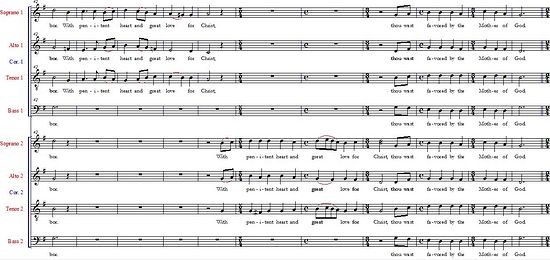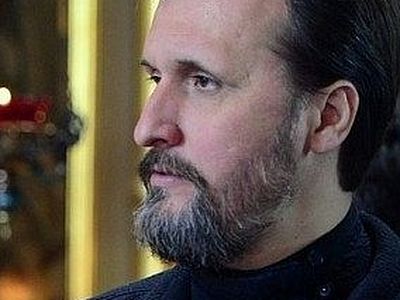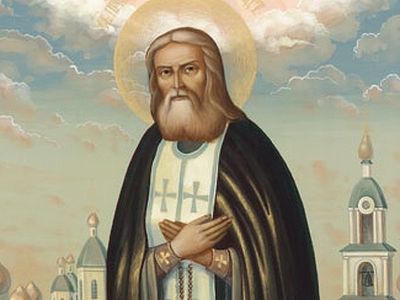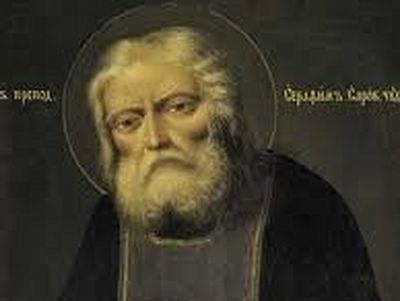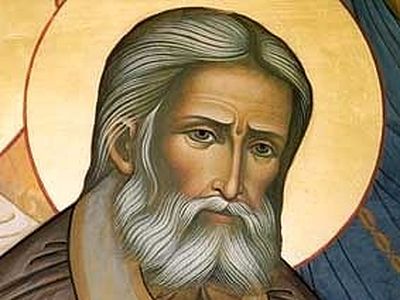
Robert Sirico is the founder of and composer for the Orthodox Christian Music Project (OCMP) which has as its purpose "proclaiming the eternal truth through sacred music." The OCMP was founded in the summer of 2009 when Fr. Jonathan Ivanoff, Rector of St. John the Theologian Orthodox Church in Shirley, NY commissioned a sacred composition to commemorate the 25th anniversary of the sounding of St. John’s church, which was premiered on December 5th, 2009 on the eve of the feast of St. Nicholas. Since that time, Robert, a professional educator and the choir director at St. John's who has been a student of music for twenty years, has been studying advanced composing techniques under the tutelage of Dr. Nicholas Reeves, who is the conductor and artistic director for the OCMP.
Since September 2012 Robert has been diligently and patiently working on his most ambitious project yet—a cantata in honor of the great Russian elder, St. Seraphim of Sarov. Incorporating official liturgical hymns as well as new hymnographic-style compositions, this piece, a first of its kind, seeks to vivify several scenes from the life of St. Seraphim through the rich spiritual heritage of the Russian Orthodox musical tradition. Robert has known the blessing of St. Seraphim in his own life, which inspired him to undertake this artistic journey.
In his communications with OrthoChristian.com, Robert's love for St. Seraphim and for our Lord Jesus Christ, and his zeal for sharing the riches of Orthodox Christianity with the public and especially the younger generations whom he educates has been palpable and inspiring. In honor of the Uncovering of the Relics of St. Seraphim, commemorated on July 19/August 1, Robert shared more of his personal history with St. Seraphim and the course of his work on this devotional cantata in an email interview with OrthoChristian.com:
* * *
—On your Orthodox Christian Music Project website you wrote that a certain Hierodeacon Parthenios introduced you to St. Seraphim ten years ago, and in our conversations you have said that your life was powerfully affected by St. Seraphim, and that you even named your daughter after him—how did you encounter Hierodeacon Parthenios, and how did he introduce you to St. Seraphim, and could you give us a fuller picture of the saint's presence in your life?
—Many years ago, shortly after my discovery of Orthodox Christianity, and long before I knew of St. Seraphim of Sarov, his powerful intercession, or of the miraculous event of his immersion in the holy Uncreated Light, I was facing a personal darkness as my late wife Lisa was diagnosed with a rare genetic breast cancer. Exasperated by stresses and strains incorporated with being a school teacher, husband, father and caregiver, my faith was tested like never before. Even though I was attending St. John the Theologian Orthodox Church in Shirley, Long Island, where I was warmly welcomed and spiritually nurtured and eventually chrismated by Fr. Jonathan Ivanoff, I found a secret refuge at the Brotherhood of the Holy Cross in Setauket, Long Island where I would visit the monastery whenever time would permit.
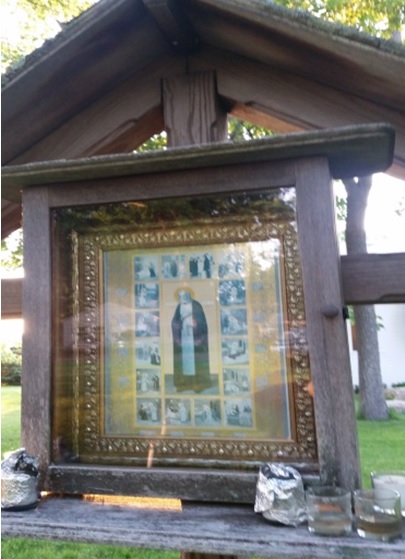 The enclosed icon of the life of St. Seraphim at Holy Cross Monastery
The enclosed icon of the life of St. Seraphim at Holy Cross Monastery
I don’t recall how long since I had been visiting the “saint in the dark” and kneeling on that large, uncomfortable rock, but one evening when I had been crying, I heard a man’s gentle voice inquire about my agony. When I looked up, I saw a monk standing by the bench who introduced himself to me as Fr. Parthenios. He invited me to sit on the bench and pour out my heart, which I did without reservation. We talked about the great mystery of illness, suffering, and death, as well as my intended conversion to Orthodoxy. I told him that I developed an affinity for the “saint in the dark” and that the only place I feel any peace is here, alone, in front of this icon, except for the rock that I had to kneel on, but I was getting used to it. Fr. Parthenios briefly introduced me to St. Seraphim of Sarov, beloved by God and devotee of the Theotokos, but it was really too dark to clearly see the icon and all of the little scenes around its border. I gathered as much that those were significant events from his life, but knowing his name was an important step since then I knew to whom I was praying. I continued to visit the monastery after work and to pray to St. Seraphim as often as I could. I even began to learn about St. Seraphim’s life as part of my spiritual development, which awakened a deep reverence for the Kursk Root icon, through which St. Seraphim himself was miraculously cured from a childhood disease.
About three years passed when my children and I were eventually chrismated into the Orthodox faith by Fr. Jonathan Ivanoff. The choir director position unexpectedly opened and since I was musically trained in composition and had been singing in the parish choir for quite some time I was asked to be the next parish choir director. Since I was still relatively new to Orthodoxy and needed the guidance and direction from an experienced maestro I enrolled in a choir director internship under Dr. Nicholas Reeves at Holy Trinity Orthodox Church (East Meadow) in the summer of 2008 and began directing once I completed the first phase of the program.
Sadly, after four years of treatment, Lisa lost her battle with breast cancer and entered her eternal rest on Pascha of 2009. My immediate responsibilities lay in providing a secure and stable home for our three children, and our home life was filled with much prayer and reading the lives of the saints, including our beloved St. Seraphim of Sarov.
—What is your personal history with Church music, and how did the idea of composing such a piece come about, and to base it on the icon of the scenes of St. Seraphim's life?
—As I entered my widowerhood, I derived much strength from the lives of the saints and the great example of St. Seraphim of Sarov as I read more about his spiritual teachings in the Little Russian Philokalia. I continued choir-director training with Dr. Reeves and began to write more music and expand my compositional output as a means of coping with the trauma, and to fulfill my expanding duties as the choir director at St. John the Theologian. It was in the early period of loss that I founded the Orthodox Christian Music Project (OCMP) with the specific intention of using my gifts to enrich the lives of others. Under the mentorship of Dr. Reeves, I continued my musical instruction and composed two concert cantatas such as the Crucifixion, as well as liturgical pieces such as the Akathist to the Mother of God, Healer of Cancer, and the Small Paraklesis which were performed in various churches like Holy Virgin Cathedral in New York City, and Holy Hierarchs Chapel at St. Vladimir’s Orthodox Theological Seminary in Crestwood, New York respectively. The OCMP sponsors a Youtube channel where previously released music is available for the edification of the faithful.
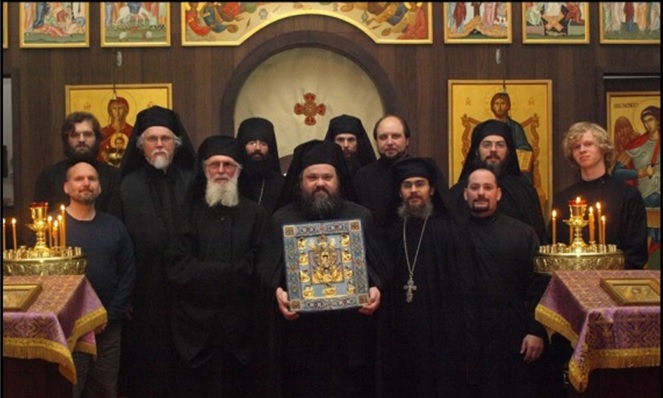 The Kursk Root Icon visits the brotherhood of the Holy Cross Monastery on 3/20/12. Rdr. Robert Sirico (1st row on end) was invited to join the brotherhood for this commemorative photograph.
The Kursk Root Icon visits the brotherhood of the Holy Cross Monastery on 3/20/12. Rdr. Robert Sirico (1st row on end) was invited to join the brotherhood for this commemorative photograph.
The years passed slowly, and I experienced a spiritual epiphany when the Kursk Root Icon of the Mother of God visited the Brotherhood of the Holy Cross on March 20, 2012. Having learned about this wonderworking icon though my spiritual reading about the life of St. Seraphim, I was awestruck that such a precious treasure would be accessible to us here in America, let alone at the very monastery where I discovered St. Seraphim. This is the icon that St. Seraphim kissed as a child; this is the icon through which the Holy Theotokos healed our beloved “little father!” With fear and trepidation I attended the Akathist and poured out my heart to the Holy Theotokos and St. Seraphim. It was after the service in the refectory that I reconnected with a woman friend who, to my surprise, had come to the monastery for the service. By God’s grace, this meeting would be the beginning of a relationship which would lead to our marriage crowning a year later. During our courtship, Kamelia suggested we visit St. Tikhon’s Monastery and Seminary in South Caanan, Pennsylvania. It was there that I had my first encounter with the relics of St. Seraphim of Sarov. When I entered the chapel for the first time ever, and saw the large icon and reliquary of St. Seraphim I was overcome with emotion and fell before him weeping. I recalled St. Seraphim’s words,
When I am dead, come to me at my grave, and the more often the better. Whatever is in your soul, whatever may have happened to you, come to me as when I was alive and kneeling on the ground, cast all your bitterness upon my grave. Tell me everything and I shall listen to you, and all the bitterness will fly away from you. And as you spoke to me when I was alive, do so now. For I am living and I shall be forever.
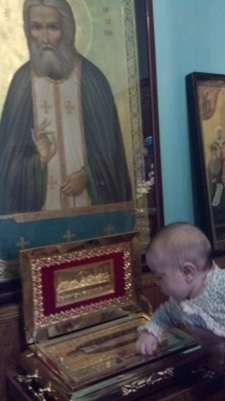 Baby Serafina meets her patron saint at St. Tkhon's Monastery for the first time
Baby Serafina meets her patron saint at St. Tkhon's Monastery for the first time
My wife Kamelia and I returned to St. Tikhon’s Monastery the following year with our new baby Serafina when she was only months old so we could visit St. Seraphim and place her under his protection. All the while I worked steadily on the research and began the arduous process of planning the composition. The historical accounts and anecdotes from St. Seraphim’s life are endless, so to simplify the process, I decided to set each scene along the circumference of the biographical icon that I first encountered many years ago at Holy Cross Monastery.
—You stated to me that as this is not a liturgical piece you can incorporate more elements than are suitable for strictly Church music. Tell us about this process of composing under a wider umbrella while remaining spiritual and respectful to St. Seraphim. What were the particular challenges involved?
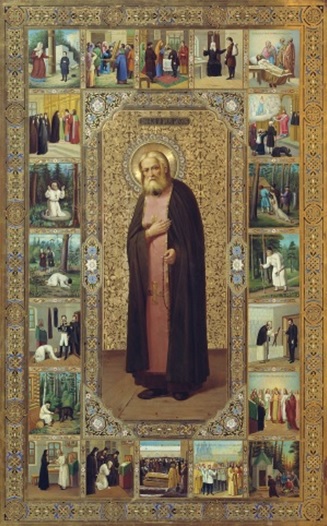 The biographical icon of St. Seraphim
The biographical icon of St. Seraphim
Nearly everyone who knows anecdotes about St. Seraphim’s life of seclusion in the forest would relate that he would feed a wild bear from his hands. It’s not mentioned in the service texts, so how would one retell that story musically? For this cantata, I chose to write the hymns in a literary style that closely resembles the tone of liturgical hymnography in voice and aspect. This allows the listener to immediately connect with the prose because the familiarity of the poetic styles “feels” like a matins canon text where there is an historical and Christological element to the subject.
Here’s the excerpt of “St. Seraphim and the Bear:”
 Portrait of St. Seraphim and the bear
Portrait of St. Seraphim and the bear
Ferocious beasts would prostrate themselves before thee; the mighty bear would surrender her honey, and the wolf her prey, in exchange for bread blessed by thy hands, O Saint.
The calming of their formidable natures showed the victory of Christ over the wolf, that natural predator of the lamb, and of the bear who fiercely pursues the bullock, as mystical symbols for the enemies of the Gospel.
Concerning the musical treatment of this text, I chose a large double choral polyphonic texture since the movement captures this mysterious, yet extremely popular event. The choir sings in an unmistakably “Russian Orthodox” way, and the melding of text and music conveys the scene in the same prayerful spirit of the services. The “Life of Saint Seraphim” is not a liturgical composition, but rather a devotional piece of music akin to an acapella oratorio. It uses many different choral ensemble textures which appear throughout the history of Russian Orthodox music, from Znamenny-styled chant of pre-Western influence through functional harmony prevalent in the works of western trained composers like Dmitry Bortniansky and Sergei Rachmaninov, among the most universally recognizable. The twenty-two movements of the cantata span over two and one quarter hours, and incorporate numerous direct quotes of St. Seraphim’s spiritual maxims sung in the first person by a tenor soloist. To facilitate a better transition between movements, there are some additional historical scenes added as a surprise for the listener. Even though the icon doesn’t include the most well-known and thoroughly documented anecdote of St. Seraphim’s life, his immersion in the holy Uncreated Light as described by Nikolai Motovilov in the famous spiritual testament A Conversation in the Snow, I feel I am obligated to faithfully relate this event because of the didactic nature of the composition. There are several other surprises in this cantata which I think the listener will truly appreciate!
—You have been working on this project for several years now. Would you say you have felt St. Seraphim’s blessing and guidance throughout this project? How has your relationship with him developed through this process?
—We labor for that in which we believe. Our Christian struggle is a lifelong pursuit, and as we progress through the annual cycle of the liturgical services, we are taught about the lives of the saints and their holy example for our spiritual benefit. The Most Holy Theotokos and the saints accompany us in our journey of prayer and repentance, and they are there in reality to guide us through the spiritual desert which they themselves passed long before we took our first steps. They know the way to Christ, and they are eager for us to find him in Spirit and truth. Let us recall that St. Seraphim had frequent recourse to St. Sergius of Radonezh and St. Barsanuphius the Great, among others, notwithstanding the Holy Theotokos.
One cannot draw near to one particular saint at the exclusion of any other. Since all saints point to Jesus Christ as the source and the fountain of life, affinity to one is communion with them all! St. John of Kronstadt explains this in detail in his treatise My Life in Christ. This project hasn’t introduced me only to St. Seraphim of Sarov, while it is true the particulars of his blessed life are detailed here, but has established for me a living connection to the league of spiritual champions who are connected to St. Seraphim from before his earthly life began, and to those who took courage from him since his bodily death and glorification.
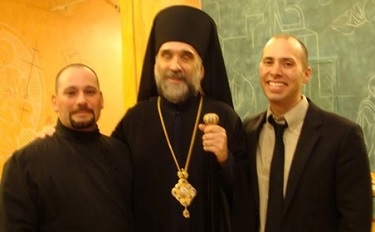 Robert Sirico (L), Archbishop Michael (OCA), and Nicholas Reeves (R) during the repast after the Cancer Akathist Prayer Service at Holy Virgin Protection Cathedral in New York City
Robert Sirico (L), Archbishop Michael (OCA), and Nicholas Reeves (R) during the repast after the Cancer Akathist Prayer Service at Holy Virgin Protection Cathedral in New York City
Whenever one begins a large undertaking there is excitement, and hope of rejoicing in blessed fulfillment. However, as a holy work commences, little time passes before weakness and struggle manifest themselves, and no doubt the machinations of the evil one who loathes that any sinner should draw nearer to the light. So for me, this project has been a struggle in many ways, from writer’s block and language barriers, historical information gaps, to the struggle against pride and ambition, lest I ever forget that apart from Christ, I can do nothing. I can assuredly say that St. Seraphim has helped me with this project, and because of this project, in that it was used to teach me about what an authentic spiritual life should be. Through it I discovered the Jesus Prayer and its primary importance for the Christian soul. Even if this music is never heard, the precious gift I received through writing it has changed my life forever.
However, I did receive little signs along the way to encourage me when doubt and confusion through my own spiritual weakness confounded me. I maintained consistent spiritual counsel from Priest-Monk John and research assistance from Father Deacon Parthenios at Holy Cross Monastery in Setauket. One such memorable occasion when it was clear that St. Seraphim assisted me was when I was perplexed at an event portrayed in the icon. To my great frustration and disappointment, I could not find any reliable historical evidence to suggest the meaning of a small scene in the lower left corner of the icon. If I could not decipher this, the project would come to an indefinite halt. After weeks of prayer and searching, I had finally uncovered the mystery of the scene on August 22, 2014, which marked the 199th anniversary of the end of St. Seraphim’s 5 year seclusion! This joyous discovery provided all the information necessary for writing the 16th movement of the cantata entitled, “The End of Seclusion” (The full account can be read in the archives of the St. Seraphim project on the Orthodox Christian Music Project website; I think you will find it is worth the read!).
When I shared the news about my discovery with the Fathers at the monastery, these experienced monks taught me to rely on the intercession of the saints, and that this was just a mere shadow of the fullest relationship we will have with them in Christ. If they would assist us in these trivial matters, how much more so would they come to our aid for the salvation of our souls. After the sacraments, it is through prayer and spiritual works that we are joined to the Body of Christ, but is by their example that we learn how to pray and devote ourselves to the holy cause of love. St. Seraphim’s words resonate with us because they are true, and he shows us how to war against the world, the flesh and the devil:
God is a fire that warms and kindles the heart and inward parts. Hence, if we feel in our hearts the cold which comes from the devil—for the devil is cold—let us call on the Lord. He will come to warm our hearts with perfect love, not only for Him but also for our neighbor, and the cold of him who hates the good will flee before the heat of His countenance.
There is nothing I would dare to add to the teachings of the saints, but employing sacred art to share faithfully their wisdom provides an opportunity for those searching to evaluate and judge for themselves as the Gospel writer says, This is a faithful saying and worthy of all acceptance, that Christ Jesus came into the world to save sinners, of whom I am chief (1 Tim 1:15). My relationship with God in Trinity, the Most Holy Theotokos, all the saints, and my neighbor is continually developing because of the heavenly grace that has been sent to me through such a great advocate. Hopefully, when anyone listens to this cantata, the story will fill them with a sense of wonder at the life of one of God’s holy ones, and the music will carry them through his life, and suffering, to his ultimate glorification.
—Have you ever been to Diveevo to venerate St. Seraphim’s relics, or do you have any plans to make a pilgrimage to there?
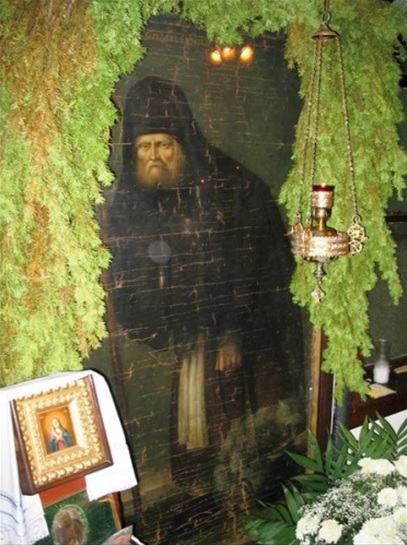 An original portrait of St Seraphim of Sarov, painted during his lifetime
An original portrait of St Seraphim of Sarov, painted during his lifetime
—You spoke of St. Seraphim’s love of children and our modern world’s need for a starets. What word does St. Seraphim have for our children today, and for parents tasked with raising godly children?
—Volumes could be written about contemporary moral ills and their deleterious effects on the spiritual formation of children. However, instead of attempting to categorize various vices and their causes, it is much simpler to simply acknowledge that we possess a fallen nature and are in need of salvation through Christ Jesus. This is what St. Seraphim as a spiritual elder taught so clearly with authority and the power of the Holy Spirit. He did not view any illness or disease as outside of the realm of spiritual sickness, but rather as a product of sin, and the work of the evil one active in the world. St. Seraphim was a spiritual warrior in the flesh and a victor in the spirit. Through his severe asceticism he conquered the temptations which gave him power over the world and made him worthy to lead men literally into the light of Christ.
St. Seraphim taught the blessedness of marriage, and loved children as “flowers of paradise.” The anecdotes of his life include numerous instances of his instructions to spouses for living a holy Christian marriage, as well as directions for parents to tend to their children’s spiritual education first, then their secular education afterwards. He taught that mothers should say the Jesus Prayer while nursing their infants so that the innocent babies would grow in faith, love, and knowledge of God. St. Seraphim would often say, “… first prepare their souls; and all these things shall be added to them afterwards (Mat 6:33).” More than a little spiritual profit would be gained if as many people as possible became familiar with the wisdom of the elders, particularly through prayer and the reading of their spiritual testaments. Just as Scripture lives forever, the saints live in Christ; when we look at them, we see the Author of life whom they perfectly reflect. St. John of Kronstadt teaches that we must truly believe that when we call on the names of the Holy Theotokos and the saints, they are really and truly present, and eager to assist us in our struggles. There are many testimonies from supplicants who have called on St. Seraphim of Sarov since his earthly life at his hermitage, through space and time to the present day. No one who appeals to his intercession is left unaided, but enriched beyond measure.
—Are there any other OCMP projects you’d like to mention?
—The mission of the Orthodox Christian Music Project is to proclaim eternal truth through sacred music. This is an ongoing process which includes the composition of new music for liturgical services or devotional settings. All of the progress, news, and events are simultaneously announced on the OCMP website and on the OCMP Facebook page so that subscribers may be the first to know and spread the word. The St. Seraphim Cantata is the next major project to fulfill the mission charter. Even though it took over two years to research and compose a biographical cantata about St. Seraphim, it is now time to generate popular interest and financial support so that the cantata can be performed, recorded, and shared with music lovers and the faithful all over the world.
In the United States, there is an increasing interest by American choirs in the literature and musical heritage of Russia and the near East, as evidenced by their more frequent performances and recordings of sacred music by such luminaries as Tchaikovsky and Rachmaninoff, as well as the rarer works by less familiar composers like Pavel Chesnokov and Alexander Gretchaninov, to name a few! Ironically, no composer of the late classical or modern era has chosen as his subject St. Seraphim of Sarov, the most celebrated Orthodox Christian saint in all of Russia, even though thousands of books and films for adults and children have been published for decades about his extraordinary life and miracle working. It was for this reason, and an act of personal devotion, that I chose to write the cantata The Life of St. Seraphim of Sarov in English, so that the story which has captivated all of Russia and the East for two centuries would be accessible to us here in the West.
I want to sincerely thank Pravoslavie.ru for giving me the opportunity to share my experience, and the evolution of the cantata The Life of St. Seraphim of Sarov. I hope that you are edified by this story. May we always remember that we are not spiritually alone in our holy works, and that all things happen in God’s time for his greater purpose. I ask you to continue to pray for the success of this project, and that through it, the life and intercession of St. Seraphim may be shown to the world in an unprecedented way.
May St. Seraphim bless us and help us to acquire the spirit of peace.
*If you would like to help support the development of the St. Seraphim Cantata and contribute to making its premiere performance a reality, please visit the webpage, A Cantata in Concert: The Life of St. Seraphim of Sarov, and donate towards the concert promotion effort.
